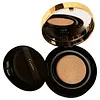What's inside
What's inside
 Key Ingredients
Key Ingredients

 Benefits
Benefits

 Concerns
Concerns

 Ingredients Side-by-side
Ingredients Side-by-side

Water
Skin ConditioningTitanium Dioxide
Cosmetic ColorantCyclopentasiloxane
Emollient2-Ethylhexylal
SolventEthyl Methoxycinnamate
UV AbsorberGlycerin
HumectantCyclohexasiloxane
EmollientCetyl Ethylhexanoate
EmollientCetyl PEG/PPG-10/1 Dimethicone
EmulsifyingPhenyl Trimethicone
Skin ConditioningEthylhexyl Salicylate
UV AbsorberPentylene Glycol
Skin ConditioningDimethicone
EmollientMethyl Methacrylate Crosspolymer
Zinc Oxide
Cosmetic ColorantSilica
AbrasivePEG-10
HumectantMagnesium Sulfate
Phenoxyethanol
PreservativeAluminum Hydroxide
EmollientDimethicone/Vinyl Dimethicone Crosspolymer
Skin ConditioningDisteardimonium Hectorite
StabilisingTrimethylsiloxysilicate
EmollientTriethoxycaprylylsilane
Betaine
HumectantStearic Acid
CleansingEthylhexylglycerin
Skin ConditioningParfum
MaskingDisodium EDTA
1,2-Hexanediol
Skin ConditioningBHT
AntioxidantAllantoin
Skin ConditioningCaffeine
Skin ConditioningCI 77492
Cosmetic ColorantCI 77491
Cosmetic ColorantCI 77499
Cosmetic ColorantWater, Titanium Dioxide, Cyclopentasiloxane, 2-Ethylhexylal, Ethyl Methoxycinnamate, Glycerin, Cyclohexasiloxane, Cetyl Ethylhexanoate, Cetyl PEG/PPG-10/1 Dimethicone, Phenyl Trimethicone, Ethylhexyl Salicylate, Pentylene Glycol, Dimethicone, Methyl Methacrylate Crosspolymer, Zinc Oxide, Silica, PEG-10, Magnesium Sulfate, Phenoxyethanol, Aluminum Hydroxide, Dimethicone/Vinyl Dimethicone Crosspolymer, Disteardimonium Hectorite, Trimethylsiloxysilicate, Triethoxycaprylylsilane, Betaine, Stearic Acid, Ethylhexylglycerin, Parfum, Disodium EDTA, 1,2-Hexanediol, BHT, Allantoin, Caffeine, CI 77492, CI 77491, CI 77499
Water
Skin ConditioningCyclopentasiloxane
EmollientCyclohexasiloxane
EmollientMethylpropanediol
SolventCaprylic/Capric Triglyceride
MaskingDimethicone
EmollientParaffinum Liquidum
EmollientSodium Chloride
MaskingCetyl Dimethicone
EmollientDimethicone Crosspolymer
Emulsion StabilisingPhenoxyethanol
PreservativeTriethoxycaprylylsilane
Sodium Hyaluronate
HumectantEthylhexylglycerin
Skin ConditioningCetyl PEG/PPG-10/1 Dimethicone
EmulsifyingEthylhexyl Methoxycinnamate
UV AbsorberWater, Cyclopentasiloxane, Cyclohexasiloxane, Methylpropanediol, Caprylic/Capric Triglyceride, Dimethicone, Paraffinum Liquidum, Sodium Chloride, Cetyl Dimethicone, Dimethicone Crosspolymer, Phenoxyethanol, Triethoxycaprylylsilane, Sodium Hyaluronate, Ethylhexylglycerin, Cetyl PEG/PPG-10/1 Dimethicone, Ethylhexyl Methoxycinnamate
Ingredients Explained
These ingredients are found in both products.
Ingredients higher up in an ingredient list are typically present in a larger amount.
This ingredient is a high molecular weight silicone. It has emulsifying and skin conditioning properties.
Cyclohexasiloxane is a type of silicone more commonly known as D6. It is an emollient and solvent.
Cyclohexasiloxane is used to evenly distribute ingredients throughout the product. When applied to the skin, Cyclohexasiloxane evaporates and leaves behind a silky feel.
As an emollient, it can help the skin feel soft and hydrated. It is also used to reduce frizz in hair products.
Learn more about CyclohexasiloxaneCyclopentasiloxane, or D5, is a silicone used to improve texture of products and trap moisture.
D5 is considered lightweight and volatile. Volatile means it evaporates quickly after application. Once evaporated, D5 leaves a thin barrier that helps keep skin hydrated.
It is also an emollient. Emollients help soften the skin and prevent water loss. Silicones create a silky texture in products. D5 helps other ingredients become more spreadable.
Studies show D5 is safe to use in skincare products. We recommend speaking with a skincare professional if you have concerns.
Learn more about CyclopentasiloxaneDimethicone is a type of synthetic silicone created from natural materials such as quartz.
What it does:
Dimethicone comes in different viscosities:
Depending on the viscosity, dimethicone has different properties.
Ingredients lists don't always show which type is used, so we recommend reaching out to the brand if you have questions about the viscosity.
This ingredient is unlikely to cause irritation because it does not get absorbed into skin. However, people with silicone allergies should be careful about using this ingredient.
Note: Dimethicone may contribute to pilling. This is because it is not oil or water soluble, so pilling may occur when layered with products. When mixed with heavy oils in a formula, the outcome is also quite greasy.
Learn more about DimethiconeEthylhexylglycerin (we can't pronounce this either) is commonly used as a preservative and skin softener. It is derived from glyceryl.
You might see Ethylhexylglycerin often paired with other preservatives such as phenoxyethanol. Ethylhexylglycerin has been found to increase the effectiveness of these other preservatives.
Phenoxyethanol is a preservative that has germicide, antimicrobial, and aromatic properties. Studies show that phenoxyethanol can prevent microbial growth. By itself, it has a scent that is similar to that of a rose.
It's often used in formulations along with Caprylyl Glycol to preserve the shelf life of products.
Triethoxycaprylylsilane is a silicone used to bind and stabilize ingredients.
As an emulsifier, it helps prevent ingredients from separating. This can help elongate the shelf life of products.
Triethoxycaprylylsilane is often used to coat mineral sunscreens ingredients to help give a better feel. It also helps reduce oxidative stress in sunscreens.
Learn more about TriethoxycaprylylsilaneWater. It's the most common cosmetic ingredient of all. You'll usually see it at the top of ingredient lists, meaning that it makes up the largest part of the product.
So why is it so popular? Water most often acts as a solvent - this means that it helps dissolve other ingredients into the formulation.
You'll also recognize water as that liquid we all need to stay alive. If you see this, drink a glass of water. Stay hydrated!
Learn more about Water